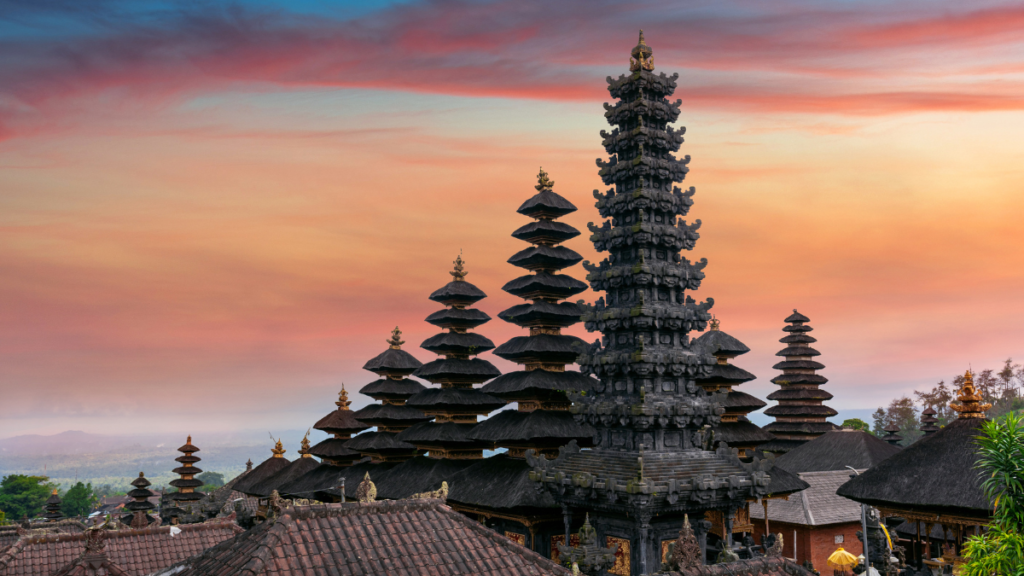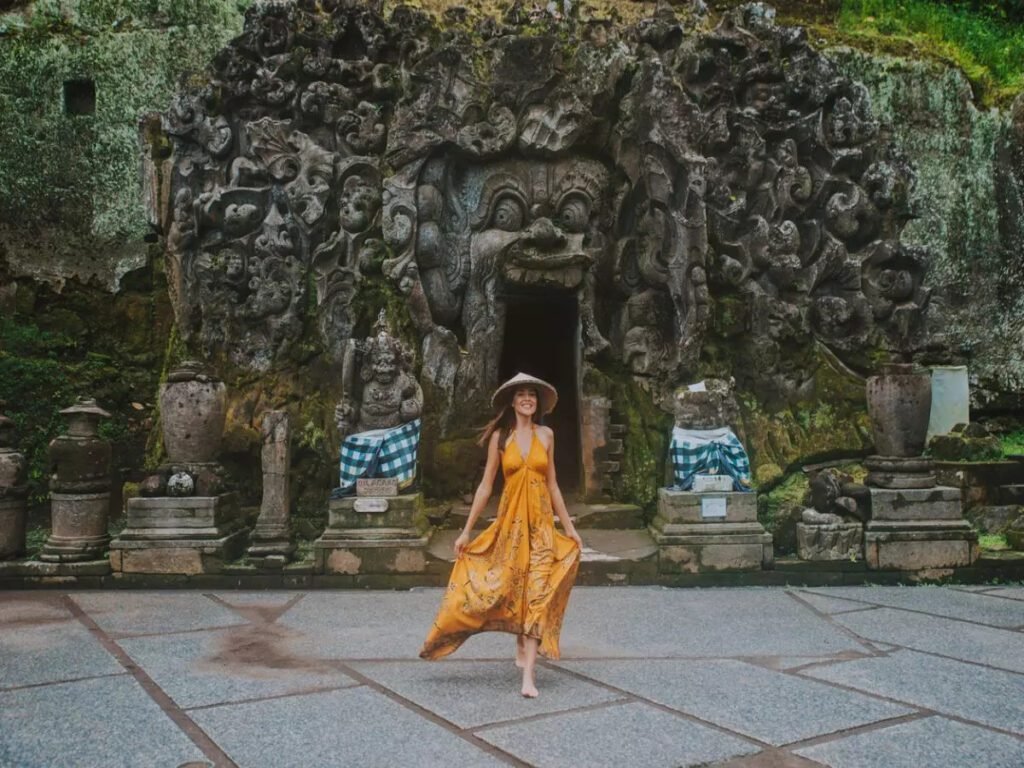Table of Contents
Bali, an Indonesian island renowned for its stunning landscapes and vibrant culture, is home to a rich tapestry of historical and spiritual heritage. This heritage is most notably exemplified through its ancient temples, which serve as the lifeblood of Balinese culture and tradition. These ancient temples in Bali are more than just places of worship; they are keystones of historical significance, architectural marvels, and central to the spiritual life of the island. Each temple tells a story, blending myth and history, and offering a window into the island’s past.
Temples such as Pura Besakih, also known as the ‘Mother Temple,’ and the coastal Tanah Lot are among the most iconic. These sacred spaces are not only religious centers but also vital tourist attractions that beckon visitors from around the globe. The allure of these temples lies in their intricate carvings, historical relics, and the serene beauty of their surroundings. The blend of nature and spirituality that these temples embody offers a unique experience for intrigued travelers and devout worshipers alike.
The role of these temples extends beyond their religious functions. They represent the island’s architectural prowess and cultural depth, acting as focal points for various traditional ceremonies and festivals. Tourists visiting these ancient temples in Bali are treated to a display of the island’s vibrant traditions, making them crucial in preserving and promoting Bali’s cultural heritage. Moreover, these sacred sites provide insights into the island’s complex history, from its Hindu roots to contemporary practices, encapsulating a sense of timelessness and continuity.
In understanding the island’s spiritual landscape, one cannot overlook the economic impact these temples generate. The influx of tourists keens on exploring Bali’s ancient temples fuels local economies, supporting countless livelihoods. Thus, the temple sites form an integral part of Bali’s identity, balancing the delicate harmony between preservation of heritage and modern tourism demands.
Tirta Empul Temple: Holy Spring Water Temple
Tirta Empul Temple, located in the village of Manukaya, near Tampaksiring, is one of Bali’s most venerated water temples. Renowned for its sacred spring water pools, Tirta Empul draws devotees and tourists alike to partake in purification rituals that have been practiced here for over a thousand years. Established in 962 AD during the Warmadewa dynasty, the temple’s historical roots deeply intertwine with Balinese culture and Hindu practices.
The temple’s architecture exemplifies the Balinese style, with meticulous carvings, intricate stoneworks, and traditional Balinese pavilions known as ‘bale.’ The key feature of Tirta Empul is the rectangular pool fed by a sacred spring through 13 elaborately sculpted spouts. Devotees line up to bathe under each spout, moving from one to the next to complete their purification ritual. It is believed that a dip in these waters can cleanse the body and spirit, offering renewed energy and spiritual cleansing.

Apart from purification rituals, visitors can engage in other activities at Tirta Empul. Walking through the temple complex provides an opportunity to appreciate the sacred architecture and lush surroundings. The temple grounds are divided into three main sections: Jaba Pura (front yard), Jaba Tengah (central yard), and Jeroan (inner yard), each holding its significance in rituals and offerings. Many visitors also partake in prayer sessions, offering ‘canang sari’ (small palm-leaf baskets filled with flowers, rice, and incense) to the temple deities.
Tirta Empul’s ongoing significance in Balinese Hindu culture, coupled with its breathtaking structural designs, makes it an essential stop for anyone exploring ancient temples in Bali. Participating in the ritualistic activities, such as the purification baths and offering prayers, provides a profound insight into the island’s spiritual heritage and enduring traditions.
Tanah Lot Temple: The Iconic Sea Temple
Tanah Lot Temple is a quintessential symbol of Bali’s spiritual and cultural heritage. Situated on a large offshore rock overlooking the Indian Ocean, this ancient temple exudes an aura of magnificence and sanctity. Its coastal location provides visitors with breathtaking views, especially during sunset, creating a picturesque backdrop that is nothing short of spectacular.
The temple’s architecture is a testament to Balinese ingenuity, with intricate carvings and designs that reflect the island’s deep-rooted religious traditions. Tanah Lot is not just a feast for the eyes but also a spiritual haven, deeply entwined with legends and mythological tales. One such story narrates the establishment of the temple by a revered Hindu priest, Dang Hyang Nirartha, in the 16th century. It is believed that he chose this dramatic site to honor the sea gods, weaving a sense of mystique into the temple’s history.

Exploring Tanah Lot offers more than just visual and spiritual gratification. Visitors can join guided tours that delve into the temple’s rich past, recounting the legends and traditions upheld over the centuries. Nearby markets brim with local crafts, souvenirs, and delectable street food, providing a delightful shopping experience. The temple grounds also host traditional Kecak dance performances, where colorful attire and hypnotic rhythms bring ancient stories to life, encapsulating the spirit of Bali’s cultural vibrancy.
Besakih Temple: The Mother Temple of Bali
Besakih Temple, reverently known as the Mother Temple of Bali, stands as the island’s largest and most significant temple complex. Nestled high on the southwestern slopes of Mount Agung, Besakih has been a sacred site for over a thousand years and continues to be a focal point of Balinese Hinduism. This extensive temple complex is not just a single construct; it comprises 23 separate, but related temples that cascade down the volcanic slopes in a series of terraces and stairways. Besakih Temple holds a powerful spiritual significance, as it is believed to be a place where the gods convene.

Visitors to Besakih can engage in a variety of enriching activities, offering a glimpse into Bali’s rich cultural tapestry. One of the most profound experiences is joining a guided tour. These tours can provide invaluable insights into the temple’s extensive history, architectural grandeur, and the intricate Hindu rituals performed here. Knowledgeable guides often share fascinating anecdotes about how the temple has withstood natural calamities, including the 1963 eruption of Mount Agung, which miraculously left much of the temple unscathed.
Attending a religious ceremony at Besakih Temple can also be an awe-inspiring experience. The temple regularly hosts days-long festivals that attract devotees from across the island. These ceremonies are vibrant with offerings, traditional music, and dance, providing an authentic window into the spiritual life of the Balinese people. Participating in these events, even as a spectator, allows visitors to feel the rhythm of devotion and piety that encapsulates the island.
Moreover, the panoramic views from Besakih Temple are nothing short of spectacular. Perched nearly 1,000 meters above sea level, the temple offers sweeping vistas of the surrounding landscape. On clear days, visitors can admire the lush, verdant rice terraces below, punctuated by distant ocean horizons. This breathtaking scenery makes the journey to Besakih Temple an unforgettable experience for anyone seeking to discover the ancient temples in Bali.
Goa Gajah: The Elephant Cave Temple
Goa Gajah, commonly referred to as the Elephant Cave Temple, is a remarkable site among the ancient temples in Bali, known for its enigmatic allure and historical significance. Dating back to the 9th century, this sacred structure offers a distinctive glimpse into Bali’s past, combining elements of Hindu and Buddhist architecture. The entrance of the cave is arguably its most iconic feature, adorned with intricate carvings that depict menacing creatures and deities, believed to ward off evil spirits. The gaping mouth of the cave’s facade serves as the doorway to this mystical sanctuary.
Once inside the cave, visitors are greeted with a small worship area featuring several lingams and a statue of Ganesha, the Hindu deity with an elephant head, which resonates with the temple’s name. The confined space inside the cave adds to its mysterious aura, making it a profound site for reflection and meditation. Surrounding the cave are serene settings that further accentuate its charm. The garden and pool area, often overlooked amid the more celebrated sections, offer a tranquil refuge, adorned with stone relics and ancient bathing pools fed by water fountains, adding to the temple’s appeal as a place of peace and purification.

The Elephant Cave Temple is more than just a historical site; it is also a living testament to Bali’s rich spiritual heritage. Sections of the temple grounds are designated for meditation, allowing visitors to engage with the sacred atmosphere on a deeper level. Archaeological excavations have revealed numerous artifacts, including fragments of religious statues, offering insights into the region’s past civilizations and their rituals. For both history aficionados and spiritual seekers, exploring Goa Gajah is an enriching experience that underscores the dynamic tapestry of Bali’s cultural landscape.
Ulun Danu Beratan Temple: The Floating Temple
Nestled on the serene shores of Lake Beratan, Ulun Danu Beratan Temple is one of Bali’s most picturesque and revered ancient temples. Often referred to as the “Floating Temple,” it derives its name from its unique architectural layout, which appears to float on the lake’s surface, particularly during the rainy season.
This iconic temple is dedicated to the lake goddess Dewi Danu, who is venerated as the deity in charge of water and agriculture. The temple’s religious significance is deeply rooted in the local Hindu-Balinese culture, and it serves as a place where spiritual rituals and offerings are made to ensure fertility and prosperity in the surrounding regions.

The Ulun Danu Beratan Temple complex impresses visitors with its distinctive multi-tiered shrines, known as Meru towers, which are a hallmark of Balinese sacred architecture. These towers stand gracefully against the backdrop of the calm lake waters and the misty highland climate, creating an ethereal atmosphere that draws tourists and worshippers alike.
Visitors to the temple can engage in a variety of activities that enhance their experience. Boating on Lake Beratan provides a unique vantage point to appreciate the full beauty of the temple and its surroundings. For those who prefer staying on land, strolling through the temple gardens offers a tranquil escape. The meticulously landscaped grounds are home to a variety of indigenous flora, adding another layer of serenity to the temple visit.
The natural and spiritual beauty of Ulun Danu Beratan Temple makes it a popular spot for photography. Capturing the morning mist hovering over the lake with the temple seemingly afloat creates postcard-perfect moments. Additionally, the reflection of the temple in the still waters of Lake Beratan provides an awe-inspiring backdrop for memorable pictures.
Ulun Danu Beratan Temple exemplifies Bali’s fusion of spiritual reverence and natural splendor. It stands not just as a place of worship but also as a testament to the island’s rich cultural heritage and breathtaking landscapes, offering a truly immersive experience for all who visit.
Entrance Fees and Tips for Visiting Ancient Temples
The allure of Bali’s ancient temples is undeniable, and understanding the typical entrance fees can help tourists plan their visits more efficiently. The entrance fees for some of the prominent temples like Tanah Lot, Uluwatu, and Besakih can range from IDR 30,000 to IDR 60,000 (approximately $2 to $4 USD). It’s advisable to carry small denominations in Indonesian Rupiah as this is the preferred currency at most entrance booths.
Visitors to Bali’s ancient temples should also consider additional costs. Parking fees are common and may range between IDR 2,000 to IDR 5,000 for motorcycles and IDR 5,000 to IDR 10,000 for cars. Furthermore, hiring a local guide can enrich the experience, with fees varying widely but typically around IDR 100,000 to IDR 300,000 ($7 to $20 USD). Guides provide valuable insights into the historical and cultural context of these sacred sites.
A visit to these ancient sites necessitates adhering to a dress code out of respect for local customs. Tourists are often required to wear a sarong and sash, which can be rented at the temple entrance if one hasn’t been brought along. Most temples provide these garments for a nominal fee or as part of the entrance ticket. Wearing modest clothing that covers shoulders is also recommended.
The best times to visit are early morning or late afternoon. These times not only offer cooler temperatures but also fewer crowds, providing a more serene experience. Planning visits around temple ceremonies can be rewarding as well, though it can mean higher foot traffic. Being mindful of temple etiquette, including not climbing on structures and maintaining a quiet demeanor, enhances the experience for all visitors and respects the sanctity of these revered sites.
Lastly, tourists should stay hydrated and use sunscreen, as many temple grounds are expansive and require considerable walking. By being well-prepared and respectful, visitors can ensure a fulfilling and memorable experience while exploring the ancient temples of Bali.
Embracing the Spiritual Journey in Bali
Bali ancient temples offer more than just visual splendor; they provide a window into the island’s rich cultural and spiritual heritage. Exploring these sacred sites allows you to delve deeply into Balinese traditions that have been preserved for generations. Whether it’s the majestic grandeur of Tanah Lot, the serene ambiance of Uluwatu, or the spiritual aura of Besakih, each temple presents a unique facet of Bali’s historical tapestry.
The temples themselves are masterpieces of intricate architecture and profound symbolism, reflecting the artistry and devotion of the Balinese people. Participating in local ceremonies, observing traditional rituals, or simply taking a moment of quiet reflection amidst the historic structures can offer profound insights into the island’s soul. By appreciating these elements, visitors not only enrich their travel experience but also contribute to the preservation of these cultural treasures.
It’s crucial for travelers to engage in respectful tourism to help safeguard these ancient temples in Bali for future generations. Simple acts such as adhering to dress codes, maintaining silence, and refraining from intrusive photography can go a long way in showing respect for these sacred sites. Tourist behavior that honors local customs and taboos allows the community to continue their age-old practices without disruption, ensuring that the spiritual essence of these landmarks remains intact.
Ultimately, Bali’s ancient temples are more than just tourist attractions; they are living entities that embody the island’s spiritual heartbeat. As you embark on your journey through these hallowed grounds, may you find not just fleeting memories, but lasting enlightenment. Understanding and preserving the cultural and spiritual heritage of Bali’s ancient temples can make your visit an enriching and deeply fulfilling experience, echoing the island’s mystical allure.
